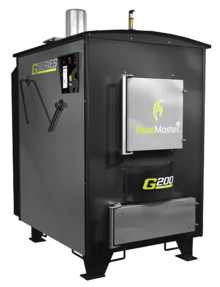Outdoor wood-fired boiler
The outdoor wood boiler is a variant of the classic wood stove adapted for set-up outdoors while still transferring the heat to interior buildings.

Technology
The outdoor wood boiler is a variant on the indoor wood, oil or gas boiler. An outdoor wood boiler or outdoor wood stove is a unit about 4-6 feet wide and around 10 feet long. It is made up of three main parts, the firebox, which can be either round or square, the water jacket, and the exhaust heat reclaiming system. The fire box ranges from 2 to 5 feet long and can be as tall as 4 feet. It is fit lengthwise inside the outer shell and is surrounded by the water jacket. The water Jacket is a second shell around the fire box which is filled with water, which is circulated through insulated underground lines to the house, where the heat can be transferred from the water to the existing heating system. After the wood is burned, the smoke is passed through the water jacket to reclaim much of the heat in the exhaust.
Standard outdoor wood boilers
Standard outdoor wood boilers heat the firebox and the smoke goes out the exhaust straight. If not run hot enough, the exhaust gas will be thick and black, and the resulting ash will not be fully rendered.[1] While functional, these models take more work and are far less efficient[2] than some newer more efficient models.
Catalytic outdoor wood boilers
Some newer outdoor wood boilers have a catalytic converter installed, to allow for a more efficient burn and treatment of the exhaust before it leaves the unit. There is a considerable difference in cost between these and standard units. These are far less popular than gasification outdoor wood boilers.[1]
Secondary combustion (gasification) outdoor wood boilers
Gassifier wood boilers use secondary combustion air to burn additional wood gases. The most sophisticated systems use computer controls to direct air at different stages of the burn process at variable volume.[3]
Outdoor wood boilers are a topic of environmental controversy.[4] An improperly used or built outdoor wood boiler can produce wood smoke with excessive unburned particulate matter, but when properly burned, studies show that burning wood is still one of the most environmentally friendly heating options. In 2007, EPA began a voluntary program to encourage manufacturers to reduce particulate levels. In 2015, the U.S. EPA updated its clean air standards for residential wood heaters, this is a mandatory standard for sales in the United States. The revised regulations apply only to new products and will not affect existing wood heaters. At this point, the only boilers that pass these emission controls are gasification models.[5]
See also
References
- Sources
- Blake, Uni (14 February 2006). "Outdoor Wood Furnace and Boiler Pollution". EnvironmentalChemistry.com.
- "Burn Wise". Environmental Protection Agency.
- "How it Works". Burnrite LLC.
- Kish, Steve (March 2007). "High Efficiency Residential Wood Boiler Modeling Assumptions Based On Monitored Data" (PDF). Michigan Department of Environmental Quality.
- "Outdoor Boilers". Technology. Alliance for Green Heat.
External links
- BurningIssues.org.
- How It Works: Outdoor Wood Furnace at AlternativeHeating.com.
- Wood Heat Organization website.
http://outdoorwoodfurnaceinfo.com